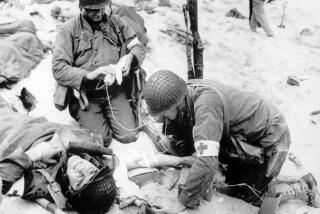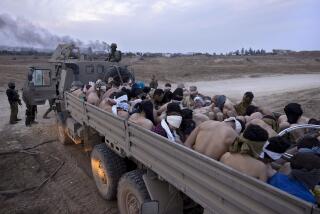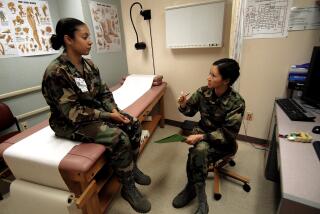Navy Studies Casualty Care on Fallouja’s Brutal Battleground
- Share via
FALLOUJA, Iraq — Navy medical officials have launched a study to determine how well their system for treating battlefield casualties functioned during the November assault by Marines and Navy SEALs on this formerly rebel-held city, the most intense urban combat for American troops since the Vietnam War.
Although “after-action” evaluations are common, this review has added significance because of the duration and ferocity of the battle and the prospect that the fight for Fallouja was a preview of street battles in Iraq and elsewhere.
“This kind of fighting is our future,” said Navy Chief Petty Officer Frank Dominguez, who was in charge of 49 medical corpsmen attached to the 3rd Battalion, 1st Regiment, 1st Marine Division, one of the lead units in the recent assault. The 1,200-strong battalion suffered 23 dead and 300 wounded.
The Navy’s surgeon general, Vice Adm. Donald Arthur, visited Fallouja last week to begin debriefing doctors and other medical personnel attached to the 3rd Battalion and the five other units that fought predominantly Sunni Muslim insurgents for more than a week.
In an Oct. 12 speech in San Diego, Arthur said he wanted to learn how well body armor protected troops, how effectively psychological trauma was treated and whether new blood-clotting bandages helped stop arterial bleeding.
Overall, Arthur said, his goal is a thorough investigation of the level of coordination among front-line corpsmen, stabilization-triage personnel and surgeons at field hospitals.
“I want to see everyone on the battlefield have the same perspective, same training, same communication and same equipment because we’re all there for the same reason,” Arthur told a trauma care symposium at the Naval Medical Center in San Diego.
The review of the Fallouja casualty care system is expected to be completed for a similar symposium this year.
At least 71 American troops and six Iraqi soldiers were killed in eight days of fighting. U.S. forces estimated that as many as 1,600 insurgents were killed in the offensive.
Five medical corpsmen who accompanied assault troops from the 3rd Battalion were wounded in Fallouja. One lost an arm, and the others were hit by shrapnel. (A sixth corpsman lost an eye in a battle last summer.)
Corpsman Quinton Brown, 24, of Chicago remembered the shock of seeing a Marine in his platoon killed while storming a building where insurgents were barricaded. Like most of those killed in action, the sergeant was wounded in the head and probably died instantly.
“I’d known him since March, when we started training,” Brown said, his words coming slowly. “To see him get hit and die, I just stood there wishing I was able to do something but, on the other hand, I wouldn’t want him to have suffered.”
Corpsman Peter Melady, 39, of San Diego said the toughest moment was watching the young, wounded Marines arrive in Humvees at a triage center set up in a train station that the Marines had taken from insurgents in one of the earliest gun battles of the assault.
“Some of the guys I’d known for three years,” Melady said. “You just put it out of your mind. It was actually good we were so busy, you had no time to dwell on it.”
The goal, he said, was to ensure that the most severely injured could be taken either by helicopter or ambulance to a field hospital within 60 minutes, thus maximizing their chances of survival.
Although the formal study has yet to be completed, corpsmen said they knew of no wounded Marine who arrived at the train station who did not survive.
“Nothing prepares you for combat,” said corpsman Michael Winkle, 21, of San Diego. “But all your medical training comes back when the time comes for it. My job is to treat people. Emotion doesn’t get in the way -- until after the fact.”
The battle for Fallouja tested a system first used during the assault on Baghdad in 2003 in which doctors were brought closer to the front than in previous wars.
Early in the fight, the train station center was within a few hundred yards of where Marines and SEALs were fighting house to house with insurgents.
“We were ready mentally and physically,” said corpsman Derek Roe, 21, of Broomfield, Colo., who accompanied a front-line unit. “The only thing you didn’t have any experience with was emotionally.”
Roe remembers being pinned down on a rooftop by snipers. At sunset, a Marine’s silhouette momentarily provided a target, Roe said, and the sniper let loose a burst, with one round finding its way beneath the Marine’s flak jacket, creasing his back.
Although the wound was not fatal, it left a unique scar, a red streak beneath a Marine tattoo, Roe said.
Dominguez, 38, of Carlsbad said medics and doctors at Fallouja relied on tourniquets to stop bleeding, overturning the medical truism that they should be used only as a last option.
“Tourniquets are now being used as the first resort to stop bleeding,” Dominguez said. “That’s what urban fighting has got us doing.”
More to Read
Sign up for Essential California
The most important California stories and recommendations in your inbox every morning.
You may occasionally receive promotional content from the Los Angeles Times.










